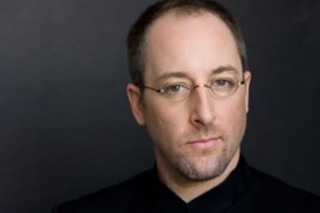|
Back
The Music of the Exotics New York
Alice Tully Hall
10/20/2016 -
Esa-Pekka Salonen: Nyx
Béla Bartók: Viola Concerto, Sz. 120
John Adams: Doctor Atomic Symphony
Matthew Cohen (Viola)
Juilliard Orchestra, Jeffrey Milarsky (Conductor)

J. Milarsky (© Peter Konerko Photography)
The Juilliard Orchestra played a concert of Exotics last night. If music had a verbal language, they would have played Suomi and Magyar and American Indian and Sanskrit. The reality is that they paired the music of the Finnish composer Esa-Pekka Salonen, the Hungarian music of Béla Bartók, and finally John Adams’ conmingled image of Robert Oppenheimer, the scientist who developed the most terrifying bomb ever created, while obsessed with Hindu mysticism and Metaphysical poetry.
Nor did the music disappoint. Jeffrey Milarsky, the great conductor of AXIOM, needed massive forces for the three works, and he energized the “student” orchestra to give some ravishing sounds. Mr. Milarsky can be a most subtle conductor with his chamber groups. But he took no chances here, and gave the most vital beats and exertions to offer the vital colors which each work needed.
Certainly that was true with Esa-Pekka Salonen’s Nyx. Mr. Salonen spends so much time in Manhattan (Deo gratias!) that one would have assumed Nyx was a paean to this town. But no, as we learned several years ago with the New York Philharmonic, this was a...well, not a portrait...but a kind of orchestral ravishment of a nebulous Greek god of creation or of night or day...whatever.
The creation out of Chaos was signaled at the beginning with a smorgasbord of horns, a chaotic stream of sounds. With the Phil, the chaotic sounds had a rhythm, a kind of aural proscenium for the further orchestral soundscapes. The Juilliard Orchestra, for all their individual brilliance, never quite got that amazing opening. But after that, Mr. Milarsky’s orchestra opened up to the most stunning musical colors.
This was the composer’s “romantic” work, and if the pictures never quite adhered, we didn’t need that. We had lush Sibelius-style strings (and the Juilliard string section was amazing). We had a delightful clarinet solo by Shen Liu, followed by more orchestral fireworks.
The moods changed as if pushed by the Muses and the Fates. Rhythmical beating by four percussionists, vivid colors with celeste, harps and gongs. An Elysian landscape followed by a congregation of gods and goddesses.
It was a stratospheric work, and Mr. Milarsky got it forces to go at it with all the muscularity which these uninhibited young players could exhibit.

M. Cohen (© Courtesy of the Artist)
It might be unfair to have another young player, the multi-award-winning violist Matthew Cohen essay Béla Bartók’s penultimate work, written by a cancer-stricken composer, the Viola Concerto. Rather, a “viola concerto” written in sketches and bits and pieces by the after a commission of $1,000 (a princely sum in 1945) by William Primrose.
The composer had studied William Walton’s Viola Concerto, but this sounds nothing like that masterpiece. It lacks the uninhibited zest of the Walton, and little real Hungarian mysticism.
Tibor Serly completed, arranged and orchestrated the piece, and not to everybody’s satisfaction. To me, the orchestra sounds more like Kodaly than Bartók, and the second movement Adagio religioso comes nowhere near what the composer himself would have done with it. (In fact, I believe that was Serly’s title, not that of Bartók.)
Yet one can easily overlook these things, for from the very first improvisatory bars to the last dancing movement (that was especially Kodaly-an), the soloist rules the roost. And after that most mellow solo introduction, Mr. Cohen performed with immaculate technique and feeling.
It was not as mellow, not as effortless as I have heard others play it (including Primrose), but Mr. Cohen has mastered all the bits and pieces of the Concerto, and doubtless will find his own voice soon enough.
The final work, John Adams’ Doctor Atomic Symphony, I prefer far to the opera, performed at the Met some years ago. Not that the music to the opera is inferior–far from it–but where he had the brilliant poetic libretti of Nixon In China and Klinghoffer, here he had mainly the letters of the scientist, the 17th Century poetry, some mundane words to go with the music.
But what music it is. Thomas May’s splendid program notes (who knew that Doctor Atomic Symphony was inspired by Sibelius’ Seventh Symphony?) gives all the pictures which Adams provides. Not literal, of course, but with mentions of storms and Tewa Indian lullabies, and the enigmatic mind of Dr. Oppenheimer himself (pictured by Andrew Jeng’s trumpet...or perhaps the trumpet was reciting a John Donne sonnet).
Like the opening Nyx, this was a great exercise for any orchestra. But where the Salonen was a series of Jackson Pollock-style pictures, John Adams’ work was easy to follow, and the Juilliard Orchestra made it effulgently delightful to hear.
Harry Rolnick
|